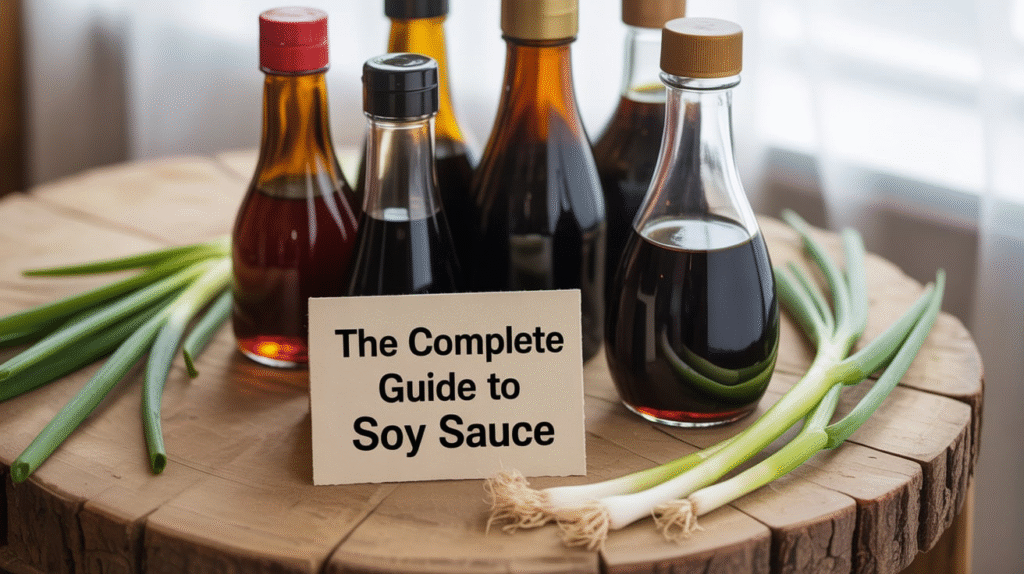Affiliate Disclosure: PantryBrands.co.uk is a participant in the Amazon.co.uk Associates Programme. As an Amazon Associate, we earn from qualifying purchases made through links on this site.
Soy sauce is one of the world’s oldest condiments, prized for its deep umami flavour and versatility in cooking. Originating in China over 2,000 years ago, it’s now a pantry staple in UK households for both Asian and non-Asian dishes. This guide covers everything from cooking uses and nutrition to different varieties and storage.

Soy Sauce Cooking & Dipping Uses
Soy sauce isn’t just for sushi, it’s a flavour enhancer across cuisines.
Here are some popular ways to use it:
- Stir-Fries & Noodles – Adds savoury depth to vegetables, meat, and seafood dishes.
- Marinades – Combine with garlic, ginger, and sesame oil for a rich, umami-based marinade.
- Dipping Sauce – Perfect for dumplings, spring rolls, and sashimi when mixed with vinegar or chilli oil.
- Soups & Stews – Enhances broth flavour in ramen, miso soup, or slow-cooked dishes.
Soy Sauce Health Benefits & Risks
While soy sauce offers flavour with minimal calories, it has pros and cons nutritionally.
- Calories – Roughly 10–15 kcal per tablespoon (15ml).
- Protein – Contains small amounts of plant-based protein.
- Sodium – High in salt (~800–1,000mg per tablespoon), which may be a concern for those on low-sodium diets.
- Antioxidants – Contains compounds like isoflavones that may have health benefits.
Tip: Low-sodium soy sauces are available, offering about 40% less salt.
Leading UK Soy Sauce Brands
Whether you want authentic Asian soy sauce or supermarket convenience, the UK offers many options.
- Kikkoman – Famous for naturally brewed, balanced flavour.
- Yamasa – Rich, full-bodied, favoured by chefs for Japanese dishes.
- Blue Dragon – Affordable, widely available in supermarkets.
- Clearspring – Organic options with traditional brewing methods.
Soy Sauce vs Tamari
Tamari is often confused with soy sauce, but there are differences.
- Soy Sauce – Brewed with soybeans and wheat, giving a balanced umami and slight sweetness.
- Tamari – Usually made without wheat, making it gluten-free and richer in soy flavour.
When to Choose: Use soy sauce for everyday cooking, tamari for gluten-free diets or when a deeper, less salty taste is preferred.
Homemade Soy Sauce Alternatives
Making traditional soy sauce at home is difficult, but you can create quick substitutes.
Simple Substitute Recipe:
- Mix beef or vegetable stock with balsamic vinegar, molasses, and a pinch of salt.
- Add garlic powder for depth.
- Use in recipes where soy sauce is unavailable.
Storage: Keep in the fridge for up to a week.
Light, Dark & Sweet Soy Varieties
Not all soy sauces taste the same – the type matters.
- Light Soy Sauce – Thinner, saltier, used mainly for seasoning and marinades.
- Dark Soy Sauce – Thicker, less salty, adds colour and richness to stews.
- Sweet Soy Sauce (Kecap Manis) – Indonesian style, syrupy with palm sugar for sweetness.
Soy Sauce Brewing Process Guide
Traditional soy sauce brewing is a slow, natural fermentation process.
- Ingredients – Soybeans, wheat, salt, and a fermentation culture (koji).
- Fermentation – Mixture ferments for months to develop complex flavour.
- Pressing & Pasteurisation – Liquid is extracted, filtered, and heat-treated for preservation.
Soy Sauce Sodium & Nutrition Facts
Knowing the nutritional breakdown helps with portion control.
- Standard Soy Sauce – 800–1,000mg sodium per tablespoon.
- Low-Sodium Soy Sauce – Around 500–600mg sodium per tablespoon.
- Calories – Minimal, making it a flavour enhancer without adding significant energy.
Soy Sauce Storage & Shelf Life
Proper storage keeps flavour fresh and prevents spoilage.
- Unopened – Store in a cool, dark cupboard for up to two years.
- Opened – Refrigerate to preserve flavour and colour; best used within six months.
Buying Authentic Soy Sauce in the UK
Look for quality indicators when choosing a bottle.
- Naturally Brewed – Indicates traditional fermentation, not chemical production.
- Ingredient List – Avoid products with artificial colouring or flavour enhancers.
- Country of Origin – Japanese, Chinese, and Korean soy sauces each have unique profiles.
FAQs about Soy Sauce
Here are some questions and answers about soy sauce.
Is soy sauce gluten-free?
Most soy sauces contain wheat, but tamari and specially labelled gluten-free soy sauces are available.
Can soy sauce be used in non-Asian recipes?
Yes – it enhances gravies, marinades, salad dressings, and even chocolate-based sauces.
Does soy sauce expire?
Unopened soy sauce lasts up to two years; once opened, it’s best consumed within six months for peak flavour.
